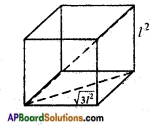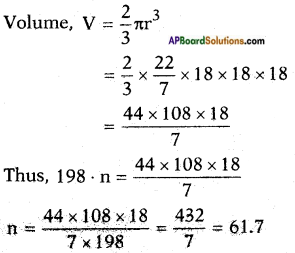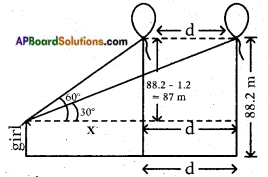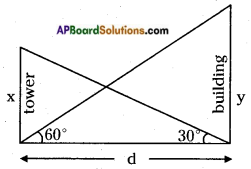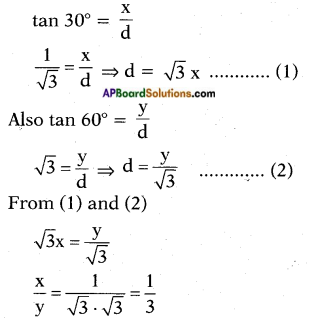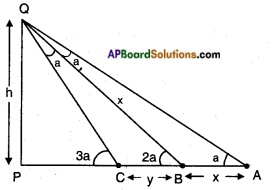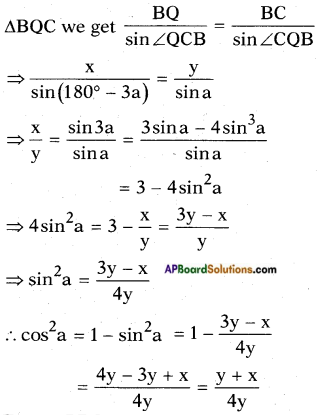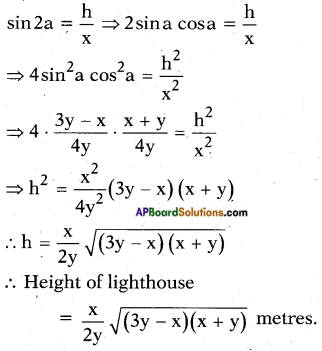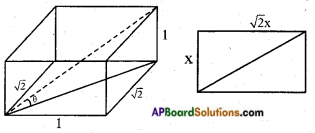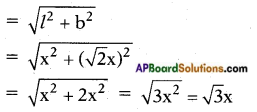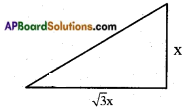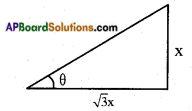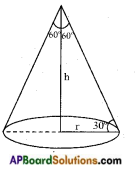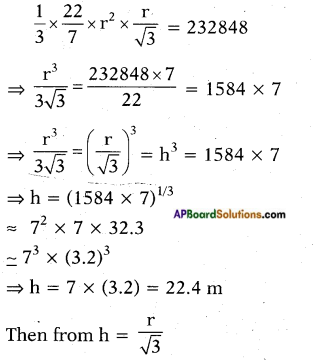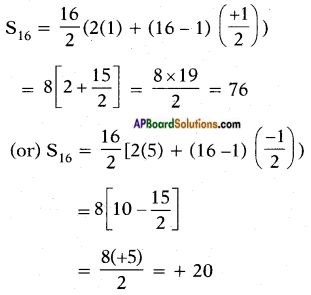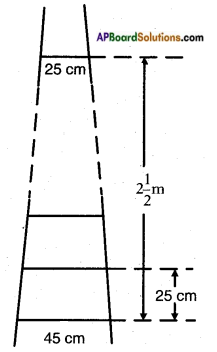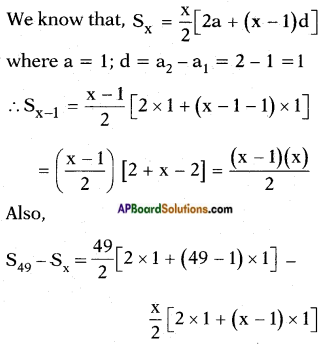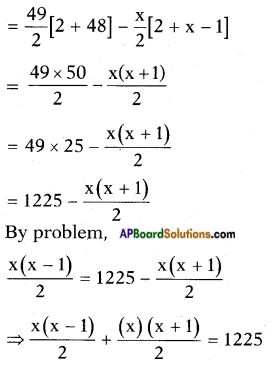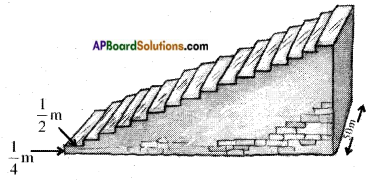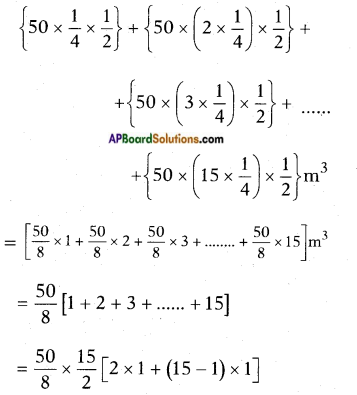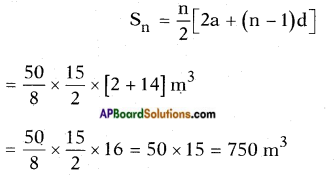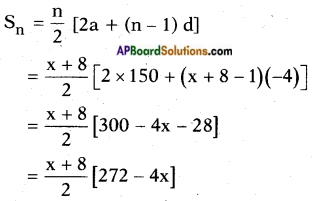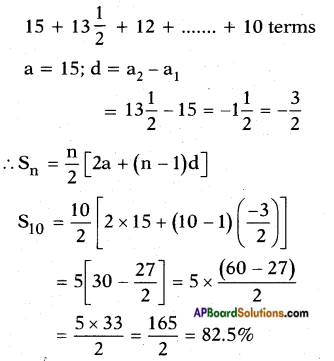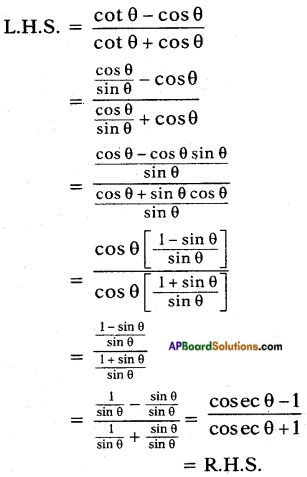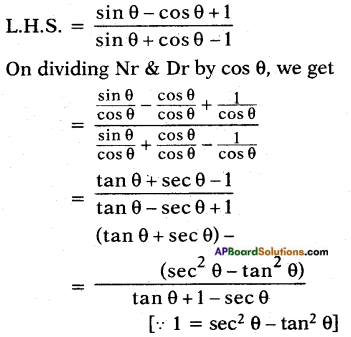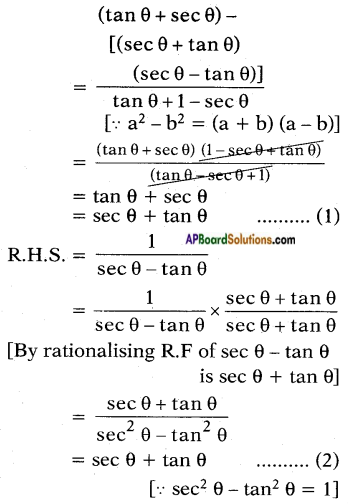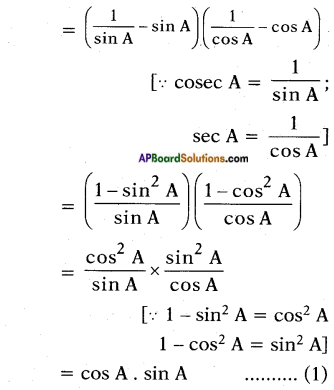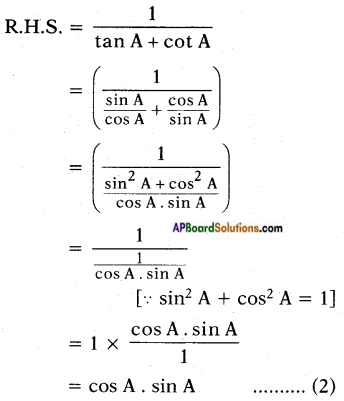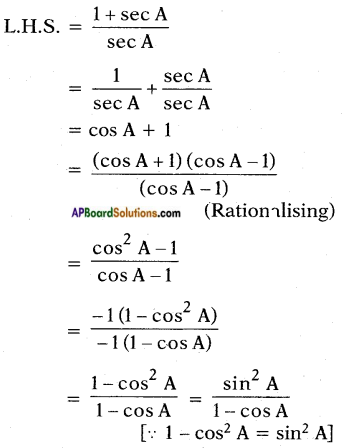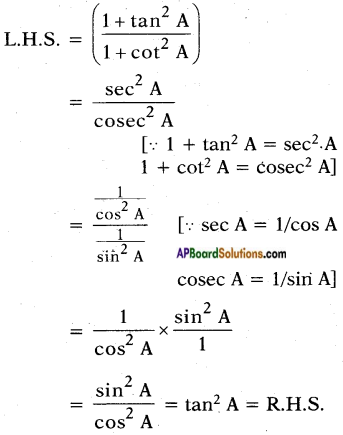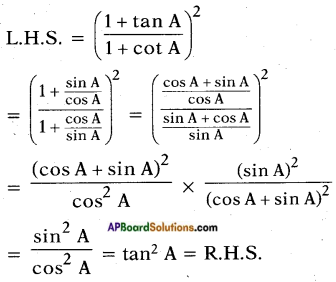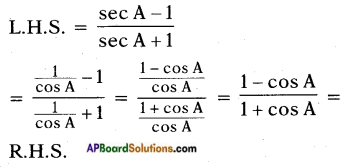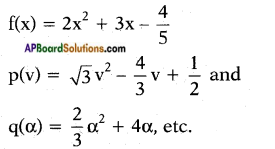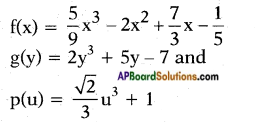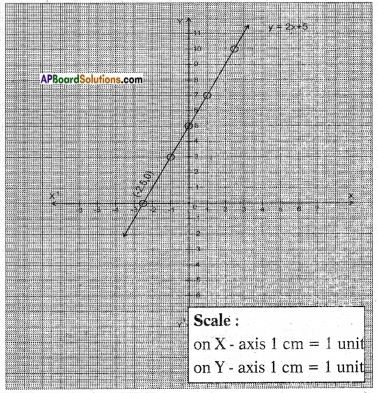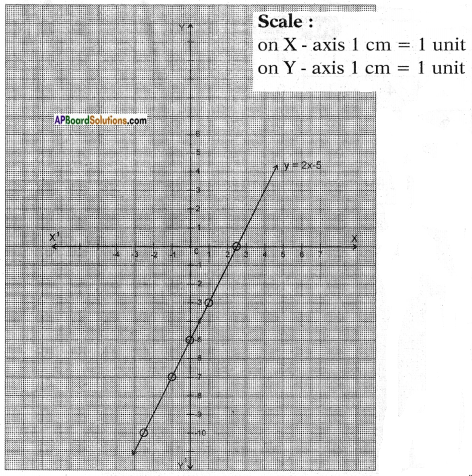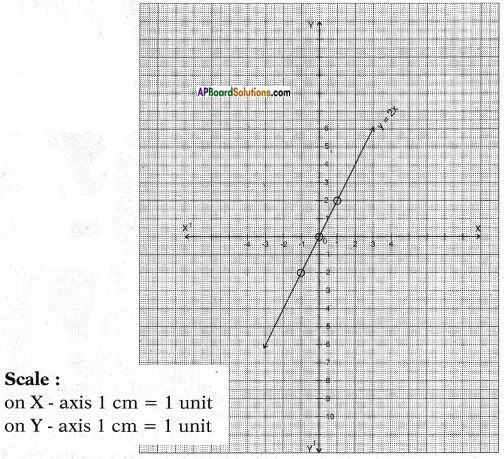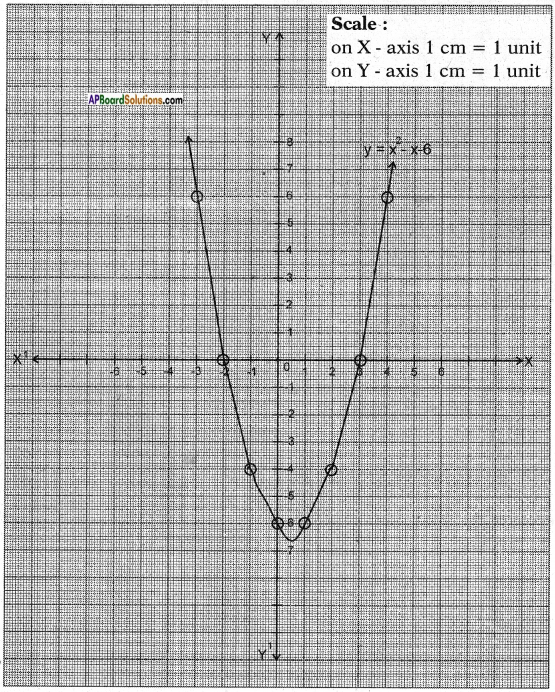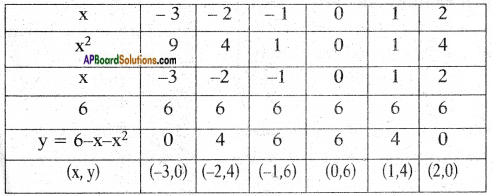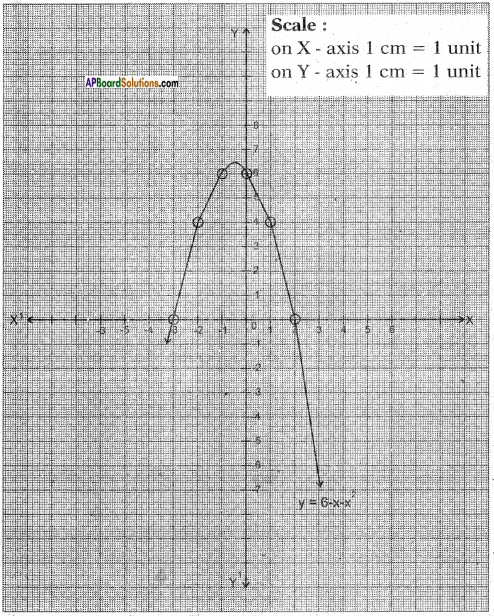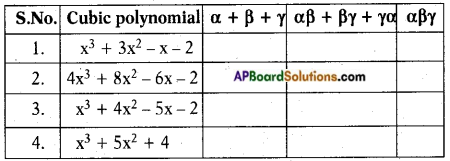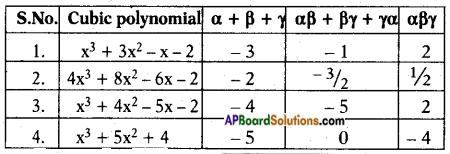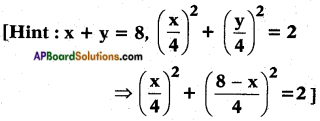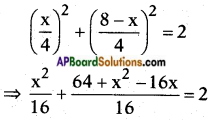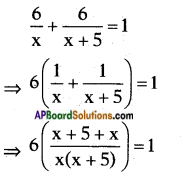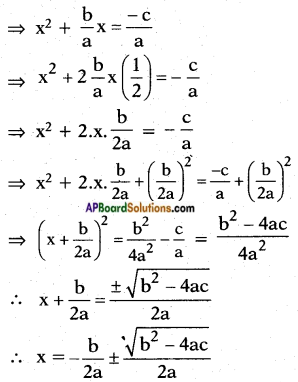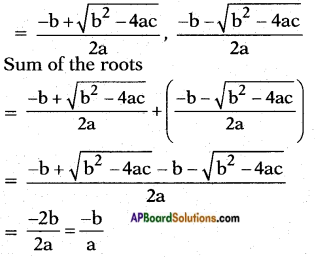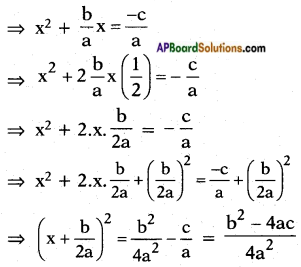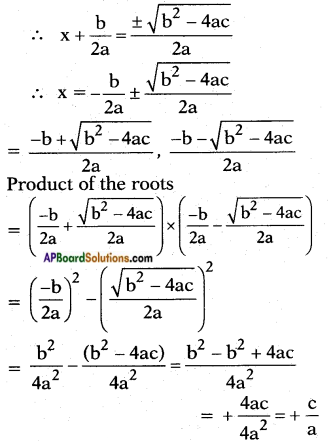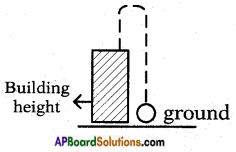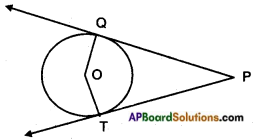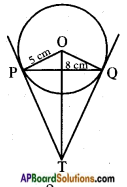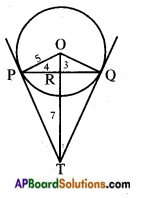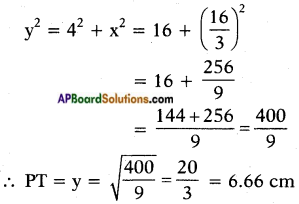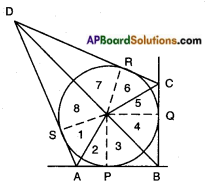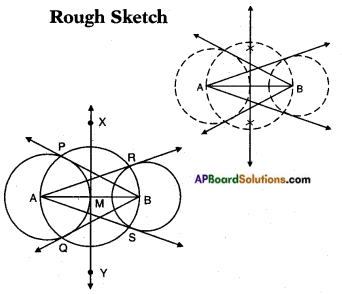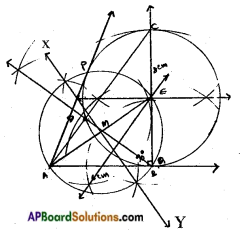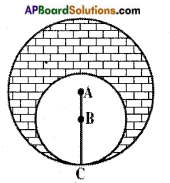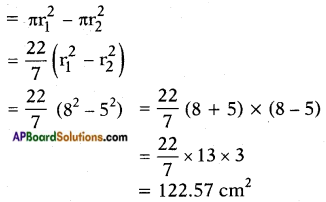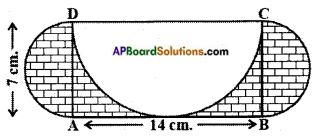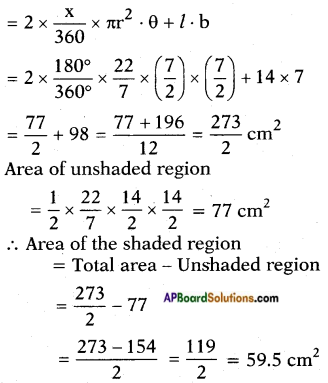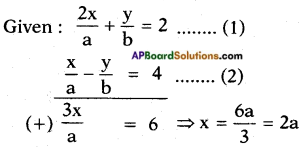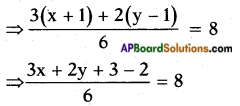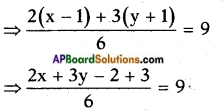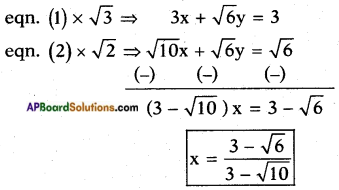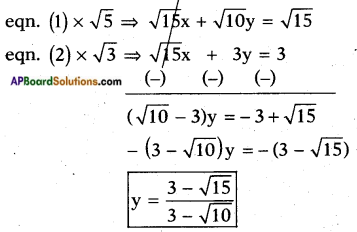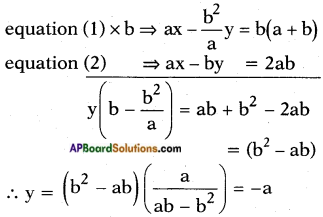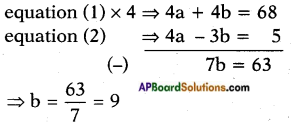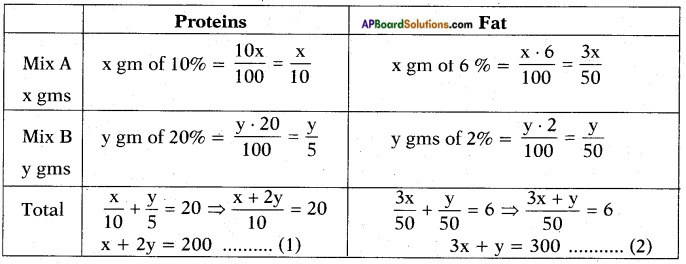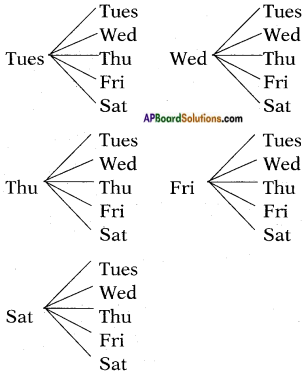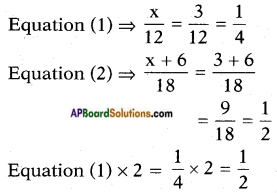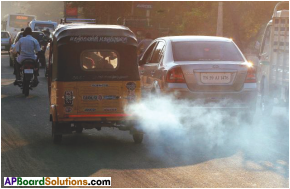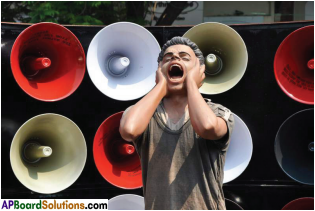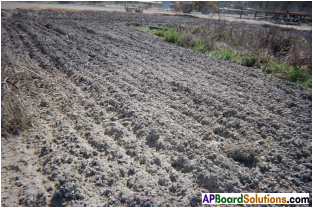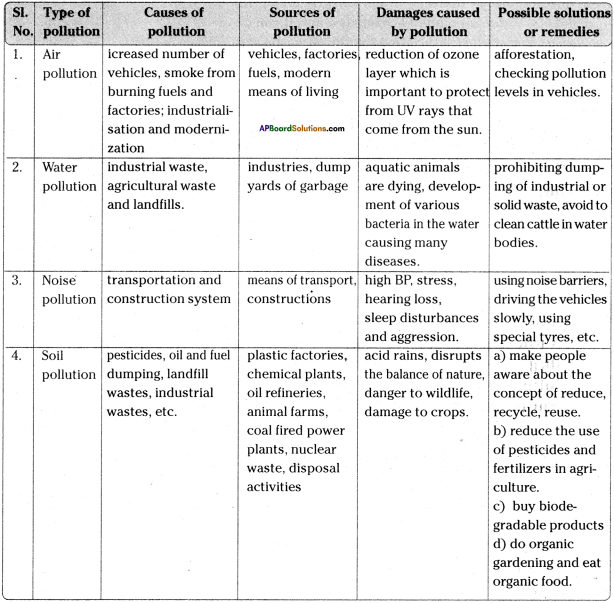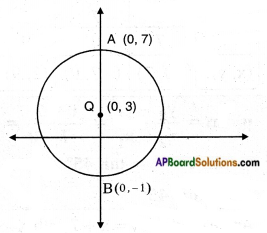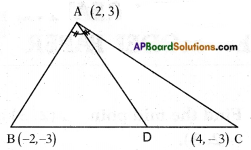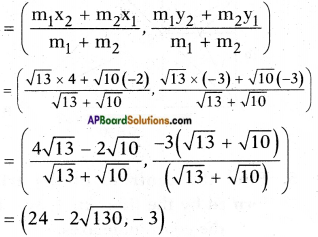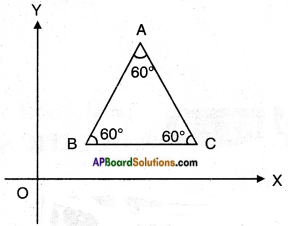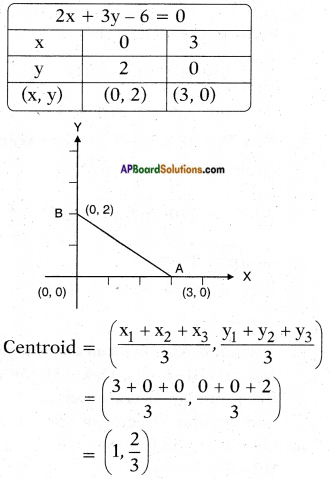AP State Board Syllabus AP SSC 10th Class Hindi Textbook Solutions Chapter 1 बरसते बदल Textbook Questions and Answers.
AP State Syllabus SSC 10th Class Hindi Solutions Chapter 1 बरसते बदल
10th Class Hindi Chapter 1 बरसते बदल Textbook Questions and Answers
InText Questions (Textbook Page No. 1)
प्रश्न 1.
मीटे गीत कौन गाती है?
उत्तर:
मीठे गीत कोयल गाती है।

प्रश्न 2.
प्यासी धरती पानी किससे माँगती है?
उत्तर:
प्यासी धरती पानी मेघों से माँगती है।
प्रश्न 3.
बादल प्रकृति की शोभा बढ़ाते हैं। कैसे?
उत्तर:
नीले गगन में काले-काले बादल छाये रहते हैं। ये बरसकर हमें पानी देते हैं। धरती पर स्थित सारी प्रकृति को जीवन दान मिलता है। हर जगह हरियाली छा जाती है। सब पानी के स्रोत भरकर सुंदर लगते हैं। प्राणिमात्र के जीवन में हर्ष उमड पडता है। सारा वातावरण खुशहाल हो शोभायमान लगता है। इस तरह बादल प्रकृति की शोभा बढाते हैं।
InText Questions (Textbook Page No. 2)
प्रश्न 1.
मेघ, बिजली और बूंदों का वर्णन यहाँ कैसे किया गया है?
उत्तर:
‘बरसते बादल’ कविता में कविवर पंतजी ने सावन के समय की प्राकृतिक चीजों का वर्णन किया है। वर्षा के समय घने काले मेघ आसमान में छाये झम – झम बरसते हैं। काले मेघों के बीच बिजली चम – चम चमकती है। वर्षा की बूंदें पेडों से छनकर छम – छम गिरती हैं।

प्रश्न 2.
प्रकृति की कौन – कौनसी चीजें मन को छू लेती हैं?
उत्तर:
सावन के समय की प्रकृति मनमोहक होती है। घुमडते बरसनेवाले घन घोर बादल, वर्षा की बूंदें, चमकनेवाली बिजली, बूंदों के रिमझिम स्वर, बहती जल धाराएँ, पेड़ – पौधे, आदि प्रकृति की चीजें मन को छू लेती हैं।
प्रश्न 3.
तृण – तृण की प्रसन्नता का क्या भाव है?
उत्तर:
धरती पर वर्षा के होने से पानी की धाराएँ बहती हैं। इससे रज के कण – कण से कोमल अंकुर फूट पडते हैं। वे खुशी से पुलकित हो झूमते हैं। धरती पर हरियाली छा जाती है। संसार के चारों ओर आनंद और उल्लास होता है। तृण – तृण की प्रसन्नता का यही भाव है।
अर्थग्राह्यता-प्रतिक्रिया
अ) प्रश्नों के उत्तर दीजिए।
प्रश्न 1.
धरती की शोभा का प्रमुख कारण वर्षा है। इस पर अपने विचार बताइए।
उत्तर:
सावन के महीने में वर्षा होती है। वर्षा से पानी मिलता है। धरती पर स्थित प्राणिमात्र को जीवन दान मिलता है। सारी प्रकृति में सब ओर हरियाली फैलती है। मिट्टी के कण – कण से कोमल अंकुर फूटते हैं। खेतों में नदी, नाले भर जाते हैं | फसलें उगती हैं। सब प्राणी खुशी से विभिन्न स्वरों में अपना आनंद प्रकट करते हैं । इस तरह कह सकते हैं कि धरती की शोभा का प्रमुख कारण वर्षा ही है।

प्रश्न 2.
घने बादलों का वर्णन अपने शब्दों में कीजिए।
उत्तर:
घने काले बादल सावन के महीने में आसमान में छाये रहते हैं। विविध आकारों में विश्रृंखलता से मंडराते हैं। भीषण ध्वनि करते वे भयानक होते हैं। उनके बीच बिजली चमक उठती है। इनकी शोभा देखनेलायक होती है। ठंडी बहार के छूते ही वे मूसलधार वर्षा देते हैं। प्रकृति में नूतन शोभा नज़र आती है। जन जीवन को आनंदमय बनाते हैं।
आ) वाक्य उचित क्रम में लिखिए।
प्रश्न 1.
हैं झम – झम बरसते झम – झम मेघ के सावन।
उत्तर:
झम – झम – झम – झम मेघ बरसते हैं सावन के।
प्रश्न 2.
गगन में गर्जन घुमड़ – घुमड़ गिर भरते मेघा
उत्तर:
घुमड – घुमड गिर मेघ गगन में भरते गर्जन।
प्रश्न 3.
धरती पर झरती धाराएँ पर धाराओं।
उत्तर:
धाराओं पर धाराएँ झरती धरती पर।

इ) नीचे दिये गये भाव की पंक्तियाँ लिखिए।
प्रश्न 1.
बादलों के घोर अंधकार के बीच बिजली चमक रही है और मन दिन में ही सपने देखने लगा है। .
उत्तर:
चम – चम बिजली चमक रही रे उर में घन के, थम – थम दिन के तम में सपने जगते मन के।
प्रश्न 2.
मिट्टी के कण – कण से कोमल अंकुर फूट रहे हैं।
उत्तर:
रज के कण – कण में तृण – तृण को पुलकावलि थर।।
प्रश्न 3.
कवि चाहता है कि जीवन में सावन बार – बार आयें और सब मिलकर झूलों में झूलें।
उत्तर:
आओ रे सब मुझे घेर कर गाओ सावन। इंद्रधनुष के झूले में झूलें मिल सब जन।।

ई) पद्यांश पढ़कर प्रश्नों के उत्तर दीजिए।
बादल और बूंदें, बंद किये हैं बादल ने
अंबर के दरवाज़े सारे, नहीं नज़र आता है सूरज ना कहीं चाँद – सितारे ?
ऐसा मौसम देखकर, चिड़ियों ने भी पंख पसारे,
हो प्रसन्न धरती के वासी, नभ की ओर निहारे॥
1. इसने अंबर के दरवाज़े बंद कर दिये हैं –
अ) आकाश
आ) सूरज
इ) चाँद
ई) बादल
उत्तर:
ई) बादल
2. पंख किसने पसारे हैं?
अ) चिड़िया
आ) मौसम
इ) धरती
ई) सितारे
उत्तर:
अ) चिड़िया
3. पद्यांश में आया युग्म शब्द है –
अ) बादल – अंबर
आ) सूरज – चाँद
इ) चाँद – सितारे
ई) धरती – वासी
उत्तर:
इ) चाँद – सितारे
4. धरती के लोग किस ओर निहार रहे हैं?
अ) चिड़िया
आ) नभ
इ) बादल
ई) चाँद
उत्तर:
आ) नभ

5. इस कविता का विषय है –
अ) प्रकृति
आ) सूरज
इ) तारे
ई) अंबर
उत्तर:
अ) प्रकृति
अभिव्यक्ति – सृजनात्मकता
अ) इन प्रश्नों के उत्तर तीन – चार पंक्तियों में लिखिए।
प्रश्न 1.
वर्षा सभी प्राणियों के लिए जीवन का आधार है। कैसे?
उत्तर:
वर्षा सभी प्राणियों के लिए आवश्यक है। वर्षा से ही संसार का चक्र चलता है। बादल वर्षा के रूप में बरसकर पानी देते हैं। धरती के सब भूभागों में पानी जमा रहता है। यह पानी पेय जल, खाना, दाना, बिजली आदि अनेक आवश्यकताओं की पूर्ति करता है। प्रकृति में हरियाली इसीसे व्याप्त होती है । वर्षा के बिना धरती पर प्राणिमात्र का जीवन यापन असंभव है। अतः कह सकते हैं कि वर्षा सभी प्राणियों के जीवन का आधार है।

प्रश्न 2.
वर्षा ऋतु के प्राकृतिक सौंदर्य पर अपने विचार लिखिए।
उत्तर:
वर्षा ऋतु सदा से सबकी प्रिय ऋतु रही है। आसमान में फैले काले, घनघोर बादल बरसते हैं। बिजली की चकाचौंध चमक होती है। वर्षा की बूंदें रिमझिम बरसती हैं। पानी की धाराओं से धरती पुलकित होती है। मिट्टी के कण – कण से कोमल अंकुर फूट पड़ते हैं। पेड – पौधे हरियाली से झूमते हैं। पशु – पक्षी, मानव और हर प्राणी आनंद विभोर हो जाते हैं। विभिन्न जीवों के आनंद स्वरों से सारी प्रकृति मनमोहक होती है।
आ) ‘बरसते बादल’ कविता में प्रकृति का सुंदर चित्रण है। उसे अपने शब्दों में लिखिए।
(या)
‘बरसते बादल कविता के आधार पर प्रकृति का वर्णन कीजिए।
(या)
‘बरसते बादल कविता का सारांश अपने शब्दों में लिखिए।
(या)
पंतजी ने वर्षा ऋतु के प्राकृतिक सौंदर्य का संदर चित्रण किया है। अपने शब्दों में लिखिए।
(या)
‘बरसते बादल’ कविता का वर्णन अपने शब्दों में कीजिए।
उत्तर:
कवि का नाम : श्री सुमित्रानंदन पंत
जीवनकाल : 1900 – 1977
रचनाएँ : वीणा, ग्रंथि, पल्लव आदि।
पुरस्कार : ज्ञानपीठ (विवंबरा) साहित्य आकादमी, सोवियत रूस।
सारांश : आधुनिक हिंदी के विख्यात कवि हैं श्री सुमित्रानंदन पंतजी। प्रकृति सौंदर्य के वर्णन में आप सुकुमार और बेजोड कवि माने जाते हैं। वीणा, ग्रंथि, पल्लव, ग्राम्या, युगांत आदि आपके प्रसिद्ध काव्य संकलन हैं। “चिदंबरा” काव्य रचना के लिए आपको ज्ञानपीठ पुरस्कार मिला।
“बरसते बादल” कविता में पंतजी ने वर्षा ऋतु का सुंदर और सजीव चित्रण किया है।
पंतजी कहते हैं कि वर्षा ऋतु हमेशा से सबकी प्रिय ऋतु रही है। उसमें भी सावन का महीना अधिक सुंदर और मनभावन होता है। सावन की वर्षा सबका मन मोहती है।
सावन के मेघ झम – झम बरसते हैं। वर्षा की बूंदें पेडों से छनकर छम – छम आवाज़ करती धरती पर गिरती हैं। मेघों के हृदय में बिजली चम – चम चमकती है। दिन में भी वर्षा के कारण अंधेरा छा जाता है। लोगों के दिलों में सपने जगने लगते हैं।
वर्षा के बरसने पर दादुर टर – टर आवाज़ करते हैं। झींगुर झींझी आवाज़ देते हैं। मोर म्यव – म्यव करते नाचते हैं। पपीहे पीउ – पीउ करके कूकते हैं। सोनबालक पक्षी गीली – खुशी से आह्वान करते हैं। आसमान पर बादल घुमडते गरजते हैं। ..
रिमझिम बरसनेयाली बूंदों के स्वर हम से कुछ कहते हैं। अर्थात् मन खुश करते हैं। उनके छूते ही शरीर के रोम सिहर उठते हैं। धरती पर जल की धाराएँ झरती हैं। इससे मिट्टी के कण – कण में कोमल अंकुर फूट पडते हैं। अर्थात् मिट्टी का हर कण अतिप्रसन्न लगता है।
वर्षा की धाराओं के साथ कवि का मन झूलने लगता है। वे लोगों को आमंत्रित करते हैं कि आप सब आइए मुझे घेरकर सावन के गीत गाइए। हम सब लोग इंद्रधनुष के झूले में झूलने का आनंद लें। यह कामना करें कि मनभावन सावन हमारे जीवन में बार – बार आये।
विशेषता : इस कविता में प्रकृति का सुंदर चित्रण अंकित किया है। इस कविता से संवेदनशीलता का विकास होता है।

इ) प्रकृति सौंदर्य पर एक छोटी-सी कविता लिखिए।
उत्तर:
ये नदियों की कल कल
ये मौसम की हलचल
ये पर्वत की चोटियाँ
ये झींगुर की सीटियाँ
कुछ कहना चाहती हैं हम से
ये प्रकृति शायद कुछ कहना चाहती है हम से ।।
ई) ‘फिर – फिर आये जीवन में सावन मनभावन’ ऐसा क्यों कहा गया होगा? स्पष्ट कीजिए।
उत्तर:
वर्षा ऋतु सबकी प्रिय ऋतु है। यह ऋतुओं की रानी कहलाती है। सावन के आने से प्रकृति रमणीय होती है। प्रकृति का कण – कण अति प्रसन्न दिखता है। पशु – पक्षी, पेड – पौधे मानव यहाँ तक कि धरती के सभी प्राणी, धरती तक खुशी से नाच उठते हैं। प्रत्येक जीवन खुशी से गीत गाने लगता है। सावन के समय बरसनेवाली वर्षा का पानी सबके जीवन का आधार है। प्राणिमात्र के जीवन यापन के लिए आवश्यक और महत्वपूर्ण है। इसीलिए कविवर पंतजी ने मनभावन सावन को बार – बार आने के लिए कहा होगा।
भाषा की बात
अ) कोष्ठक में दी गयी सूचना पढ़िए और उसके अनुसार कीजिए।
1. तरु, गगन, घन (प्रत्येक शब्द का वाक्य प्रयोग करते हुए पर्याय शब्द लिखिए।)
उत्तर:
वाक्य प्रयोग
तरुः – हमें तरु फूल और फल देते हैं।
गगन – हवाई जहाज़ गगन में उड़ रहा है।
घनः – आसमान में काले घन छाये हुये हैं।
पर्याय शब्द
तरु – पेड, पादप, वृक्ष
गगन – आकाश, आसमान, नभ
घन – बादल, मेघ

2. साक्न, सपना, सूरज (एक-एक शब्द का तत्सम रूप लिखिए।)
उत्तर:
तत्सम रूप
सावन – श्रावण सपना – स्वप्न
सूरज – सूर्य
3. गण, वारि, चंद्र (एक-एक शब्द का तद्भव रूप लिखिए।)
उत्तर:
तदभव रूप
गण – गन
वारि – बारि
चंद्र – चाँद
4. चम – चम, तृण – तृण, फिर – फिर (पुनरुक्ति शब्दों से वाक्य प्रयोग कीजिए।)
उत्तर:
चम – चम = बिजली चम – चम चमक रही है।
तृण – तृण = तृण – तृण पुलकित हो रहा है।
फिर – फिर = सावन फिर – फिर आता तो कितना अच्छा होगा।
आ) इन्हें समझिए और सूचना के अनुसार कीजिए।
1. धाराओं पर धाराएँ झरती धरती पर। (अंतर स्पष्ट कीजिए।)
उत्तर:
यहाँ पंत जी ने “धारा” शब्द को दो. बार प्रयोग किया हैं। यह संज्ञा शब्द है। इसका बहुवचन रूप ‘धाराएँ’ है। इसके साथ “पर” कारक जोडने से “धाराएँ” शब्द रूपांतरित होकर “धाराओं” बन गया है। इस प्रकार के वर्णन से वाक्य का सौंदर्य बढ़ता है।
(अंतर स्पष्ट कीजिए।)
“झूले” शब्द का मूल रूप झूला है। यह संज्ञा शब्द है। इसके साथ में “में” कारक के जोडने से झूले में रूपांतरित हो गया है। “झूलें” शब्द तो ‘झूलना’ क्रिया का रूपांतरण है।
(रेखांकित शब्द का पद परिचय दीजिए।)
संज्ञा, जातिवाचक संज्ञा, पुंलिंग, बहुवचन, कर्ता कारक।
एक शब्द में लिखिए।)
मनभावन
(समास पहचानिए।)
द्वंद्व समास
द्वंद्व समास
खेलते – कूदते बच्चे तंदुरुस्त रहते हैं।
बहते पानी में गंदगी नहीं रहती है।
उडती पंछी वर्षा में भीग गयी है।
रोती बच्ची माँ की गोद पहुंची।
हँसते और खिलते फूलों से उद्यान भरा है।
झम-झम-झम-झम मेघ बरसते हैं सावन के,
छम-छम-छम गिरती बूंदें तरुओं से छन के।
अलंकार शब्द का अर्थ है – आभूषण। किसी बात को साधारण ढंग से न कहकर चमत्कार व सौंदर्यपूर्ण ढंग से कहना ही अलंकार है।
इस कविता में अनुप्रास अलंकार का सुंदर प्रयोग हुआ है। जब वाक्य में कोई अक्षर या शब्द बार – बार प्रयोग होता है तो वहाँ वाक्य का ध्वन्यात्मक सौंदर्य बढ़ जाता है। इस प्रकार का काव्य – सौंदर्य अनुप्रास अलंकार कहलाता है।
परियोजना कार्य
वर्षा, बादल, नदी, सागर, सूरज, चाँद, झरने आदि में किसी एक विषय पर प्रकृति वर्णन से जुड़ी कविता का संग्रह कीजिए। कक्षा में उसका प्रदर्शन कीजिए।
चाँद
चम – चम – चम – चम चंदा चमके
तारे चमके झिलमिल।
आओ – आओ खेले हिल मिल
आज – चाँदनी में हम – सब ।।
ठंडी – ठंडी हवा बह रही
लोरी – सी कुछ गाती।
अभी नहीं सोयेगा कोई
नींद किसे है आती ।।
देखो धीमे – धीमे झूमीं
फूलों के ये पाँखें।
जुही, चमेली चमकी जैसे
बगिया की सौ आँखें।।
खूब भरी है नदी दूध हो
दूध भरा है झरना।
अच्छा लगता आज सभी को
दूर – दूर तक फिरना।
अरे चाँद, तुम कौन बताओ
चाँदी की थाली – से।
प्यारे तारे, झरे फूल से
बोलो, किस डाली से ॥

झरना
कल – कल करता झरना बहता
कानों में रस घोल रहा है।
गुनगुनी धूप, रेत की चादर
माता के आंचल में छुपाकर
जैसे बच्चा सो रहा है।
कल – कल करता झरना बहता
कानों में रस घोल रहा है।
कलख करते पंछी गाते,
तोता मैना गीत सुनाते
मेरा भी मन डोल रहा है।
कल – कल करता झरना बहता
कानों में रस घोल रहा है।
नीला अंबर, मीठा पानी,
प्रकृति कहे सुनो कहानी
जग अपने पट खोल रहा है
कल – कल करता झरना बहता।
कानों में रस घोल रहा है।
बरसते बदल Summary in English
Introduction of the lesson:
Rainy season is always endearing to all. It is worth watching that the beauty of a rainy day. The surrounding nature, flora and fauna, human beings, birds and the Mother Earth sway with ecstasy. This beautiful expression is described here.
Shravana clouds are raining. Rain drops are falling on the branches of trees. Flashes of lightnings are occurring from the hearts of clouds. Though it is a daytime with sunshine, it is dark because of cloudy sky and so dreams are awakening in everybody’s hearts.
Frogs are croaking. Crickets are screaming. Peacocks are dancing beautifully. Swallows are staring at the clouds. Water birds are flying happily making cries. The clouds are spreading over the sky making thundering sounds.
Raindrops are telling something. On touching them, we become horrent. It is raining with flows. Every particle in the earth is startling and tender sprouts are coming out of the earth.
My heart is rocking holding the flows of rain. Come ……. encircle me and sing the songs of Shravana. Let’s go up together in the swing of rainbow. Let’s welcome Shravana into our lives which enlivens and enthralls our hearts again and again.
बरसते बदल Summary in Telugu
ఝమ్ – ఝమ్ – ఝమ్ – ఝమ్ శ్రావణ మేఘాలు వర్షిస్తున్నాయి. చెట్ల కొమ్మలపై ఛమ్ – ఛమ్ – ఛమ్ అంటూ వర్షపు చినుకులు (బిందువులు) పడుతున్నాయి. మేఘాల నుండి (మేఘపు హృదయాల) విద్యుత్ మెరుపులు చమ్ – చమ్ మెరుస్తున్నాయి. ఎండ ఉన్న పగలు అయినప్పటికీ మేఘావృతమై యుండుటవలన కలిగిన చీకటిలో అందరి మనస్సుల్లో స్వప్నాలు జాగృతమవుతున్నాయి.
ఈ కప్పలు టర్ టర్మంటు అరుస్తున్నాయి. కీచురాళ్ళు కీచు కీచుమంటూ ధ్వనిస్తున్నాయి. నెమళ్ళు మ్యవ్ – మ్యవ్ మంటూ నృత్యం చేస్తున్నాయి. పీవు, పీవుమంటు చాతక పక్షులు మేఘాల వంక చూస్తున్నాయి. జలపక్షులు ఆర్ధ సుఖంతో ఎగురుతూ ఆక్రందన చేయుచున్నాయి. మేఘాలు గగనతలంలో గర్జన చేస్తూ ఆకాశాన్ని కమ్ముకున్నాయి.
రిమ్- జిమ్ – రిమ్ – జిమ్ అంటూ వర్షపు చినుకులు ఏదో చెబుతున్నాయి. వాటిని తాకితే వెంట్రుకలు నిక్కబొడుచు కుంటున్నాయి. ధారలు ధారలుగా వర్షం భూమిపై కురుస్తోంది. మట్టిలోని అణువణువు పులకరించి పోగా నేల నుండి కోమలమైన మొక్కల మొలకలు చిగురిస్తున్నాయి.
వర్షపు ధారలను పట్టుకొని నా మనస్సు ఊగుతోంది. రండి అందరూ నన్ను చుట్టుముట్టి శ్రావణ గీతాలను ఆలపించండి. ఇంద్రధనుస్సు ఊయల ఊపులలో మనమందరం కలసి ఊగుదాం. మన జీవితంలోకి మళ్ళీ మళ్ళీ మనస్సును ఆహ్లాదపరచే
శ్రావణం రావాలి.
अभिव्यक्ति-सृजनात्मकता
2 Marks Questions and Answers
निम्नलिखित प्रश्नों के उत्तर दो या तीन वाक्यों में लिखिए।
प्रश्न 1.
तृण – तृण की प्रसन्नता का क्या भाव है?
उत्तर:
धरती पर वर्षा के होने से पानी की धाराएँ बहती हैं। इससे रज के कण – कण से कोमल अंकुर फूट पडते हैं। वे खुशी से पुलकित हो झूमते हैं। धरती पर हरियाली छा जाती है। संसार के चारों ओर आनंद और उल्लास होता है। तृण – तृण की प्रसन्नता का यही भाव है।
प्रश्न 2.
धरती की शोभा का प्रमुख कारण वर्षा है। इस पर अपने विचार बताइए।
उत्तर:
सावन के महीने में वर्षा होती है। वर्षा से पानी मिलता है। धरती पर स्थित प्राणिमात्र को जीवन दान मिलता है। सारी प्रकृति में सब ओर हरियाली फैलती है। मिट्टी के कण – कण से कोमल अंकुर फूटते हैं। खेतों में नदी, नाले भर जाते हैं। फसलें उगती हैं। सब प्राणी खुशी से विभिन्न स्वरों में अपना आनंद प्रकट करते हैं । इस तरह कह सकते हैं कि धरती की शोभा का प्रमुख कारण वर्षा ही है।
प्रश्न 3.
वर्षा से प्रकृति की सुंदरता बढ़ती है। कैसे?
उत्तर:
आसमान में काले बादल छा जाते हैं।
- वर्षा की बूंदें तरुओं पर गिरते हैं। वह दृश्य बड़ा रमणीय है।
- बिजली आसमान के हृदय में चम – चम चमकती है। इस तरह वर्षा से प्रकृति की सुंदरता बढ़ती है।

प्रश्न 4.
वर्षा ऋतु सबकी प्रिय ऋतु है। क्यों?
उत्तर:
निम्नलिखित कारणों से वर्षा ऋतु सबकी प्रिय ऋतु है :
- वर्षा के समय आसमान को घने बादल घेर लेते हैं ।
- बादलों के उर में से बिजली चमक उठती है।
- मेघों के टकराने से मेघ गर्जन भी निकलता है ।
- आसमान में इन्द्रधनुष भी निकलता है । थम-थमाते दिन में भी अंधेरा फैल जाता है |
प्रश्न 5.
वर्षा की कमी या अधिकता हम पर कैसा प्रभाव डालती है?
उत्तर:
- सारी प्रकृति पर वर्षा का प्रभाव बहुत अधिक है।
- वर्षा की कमी के कारण खेत, तालाब, नाले, और नदी सब सूख जाते हैं।
- पीने का पानी की भी कमी होता । यदि वर्षा अधिक हो तो बाढ़ निकलते।
- खेत सड जाते | घर – गाँव डूब जाते।
प्रश्न 6.
वर्षा के समय सभी प्राणी पुलकित होते हैं । वर्णन कीजिए।
उत्तर:
वर्षा के समय सभी प्राणी पुलकित होते हैं। इस कविता में कवि ने खासकर कुछ जीवों का वर्णन किया है। बारिश के मौसम में दादुर टर – टर करते हैं। झींगुर झन – झन बजते हैं। मोर म्यव – म्यव करते हैं। चातक पीऊ – पीऊ बोलते हैं। सोन बालक जल पक्षी आर्दता का सुख पाकर क्रंदन करता है।
प्रश्न 7.
वर्षा के समय प्रकृति की सुंदरता बढ़ती है। कैसे ?
उत्तर:
पेड – पौधे हरे – भरे होकर फल – फूलों से लद जाते हैं। हर तरफ़ हरियाली छा जाती है। फुलवारी महकने लगती है। पक्षी भी पेड़ों के पास आकर चहचहाने लगते हैं। खेत फसलों से लहलहाने लगते हैं। नदी – नाले सारे के सारे पानी से भर जाते हैं। मछलियाँ मस्त होकर नृत्य करने लगती हैं। मनुष्यों में दुगुना उत्साह भर जाता है। इस प्रकार वर्षा के समय प्रकृति की सुंदरता बढ़ती हैं।

प्रश्न 8.
बरसते बादलों को देखकर किसान क्यों प्रसन्न होते हैं?
उत्तर:
नीलाकाश में काले – काले बादल छाये रहते हैं। ठंडी हवा लगते ही वे पानी बरसते हैं। बरसते बादलों को देखकर किसान प्रसन्न होते हैं। किसान लोग खेती बाडी करके आवश्यक खाद्य पदार्थ पैदा करते हैं। खेती बाडी के लिए वर्षा की आवश्यकता है। वर्षा के होते ही किसान खेत जोत कर फसल उगाते लगते हैं। सिंचाई के लिए भी पानी चाहिए। बीज बोने से लेकर फसल उगने तक पानी की आवश्यकता है। इसलिए ऐसा महत्वपूर्ण पानी बरसनेवाले मेघों को देखकर किसान बहुत प्रसन्न होते हैं।
प्रश्न 9.
आपकी प्रिय ऋतु क्या है ? क्यों?
उत्तर:
- मेरी प्रिय ऋतु वर्षा ऋतु है । वर्षा ऋतु हमेशा से सबकी प्रिय ऋतु है ।
- वर्षा के समय प्रकृति की सुंदरता देखने लायक होती है |
- पेड़ – पौधे, पशु-पक्षी, मनुष्य और यहाँ तक कि धरती भी इस ऋतु में खुशी से झूम उठती है ।
- आसमान में निकले इंद्रधनुष, काले – काले बादल, बादलों से उत्पन्न होनेवाली बिजली आदि इस ऋतु में प्रकृति की शोभा बढाते हैं । इस ऋतु में सर्वत्र हरियाली मन मोह लेती है ।
अभिव्यक्ति-सृजनात्मकता
4 Marks Questions and Answers
निम्नलिखित प्रश्नों के उत्तर छह पंक्तियों में लिखिए।
प्रश्न 1.
सुमित्रानदनं पंत के बारे में आप क्या जानते हैं?
(या)
पंत जी प्रकृति के बेजोड कवि हैं। उनके बारे में आप क्या जानते हैं?
(या)
प्रकृति वर्णन में बेजोड कवि सुमित्रानंदन पंतजी का परिचय दीजिए।
(या)
कवि “सुमित्रानंदन पंत” के बारे में आप क्या जानते हैं?
(या)
उत्तर:
- प्रकृति के बेजोड कवि माने जाने वाले सुमित्रानंदन पंत का जन्म सन् 1900 में अल्मोडा में हुआ।
- साहित्य लेखन के लिए इन्हें ‘साहित्य अकादमी’, ‘सोवियत रूस’ और ‘ज्ञानपीठ पुरस्कार’ दिया गया।
- इनकी प्रमुख रचनाएँ हैं – वीणा, ग्रंथि, पल्लव, गुंजन, युगांत, ग्राम्या, स्वर्णकिरण, कला और बूढ़ा चाँद तथा चिदंबरा आदि।
- इन्हें चिदंबरा काव्य संकलन पर ज्ञानपीठ पुरस्कार से सम्मानित किया गया।
- इनका निधन सन् 1977 में हुआ।
प्रश्न 2.
वर्षा ऋतु के प्राकृतिक सौंदर्य पर अपने विचार लिखिए।
उत्तर:
वर्षा ऋतु में प्रकृति बहुत सुंदर लगती है। चारों ओर हरियाली ही हरियाली रहती है। वर्षा की पहली बूंद जब धरती को चूमती है, तब उसका सुंगध वर्णनातीत होता है। वर्षा में खेलकर बच्चे पुलकित होते हैं। कलियाँ खिलती हैं।
वर्षा के कारण हर गली में नदियाँ बहती हैं। उन नदियों में बच्चे कागज़ की नावें छोडते हैं। वर्षा के कारण जन-जन का मन उल्लास से भर जाता है। पेडों पर नये-नये पत्ते आते हैं और नया – नया सुंगध फैलाते हैं। वर्षा ऋतु हमेशा सबकी प्रिय ऋतु रही है। वर्षा के समय प्रकृति की सुंदरता देखने लायक होती है।

प्रश्न 3.
सुमित्रानंदन पंतजी को प्रकृति सौंदर्य चित्रण का बेजोड़ कवि कहा गया है। “बरसते बादल” कविता के आधार पर इस कथन की पुष्टि कीजिए।
उत्तर:
पंतजी ने “बरसते बादल” कविता में सुंदर, मधुर शब्दों का प्रयोग किया है। जिस प्रकार आभूषण नारी की सुंदरता को बढ़ा देते हैं। उसी प्रकार पंतजी ने शब्द रूपी आभूषणों से कविता को सजाकर प्रकृति के सौंदर्य को दुगुना कर दिया है। कविता में टर – टर ,कण – कण, तृण – तृण, म्यव – म्यव, पीउ – पीउ शब्द के प्रयोग से, तो कहीं अर्थ के चमत्कार से (थम – थम दिन के तम में) तो कहीं शब्द – अर्थ दोनों के चमत्कार से (झम – झम – झम मेघ) प्रकृति की सुंदरता का अद्भुत चित्रण किया है। इस प्रकार अन्य कोई भी कवि प्रकृति सौंदर्य का चित्रण करने में असमर्थ है। इसीलिए पंतजी को प्रकृति सौंदर्य चित्रण का बेजोड़ कवि कहा गया है।
प्रश्न 5.
सावन में पेड़ – पौधे, पशु – पक्षी और मनुष्य खुशी से झूम उठते हैं। कारण बताइए।
उत्तर:
वर्षा होने पर ही पानी मिलता है। हर प्राणी.को जीवन जीने के लिए पानी ज़रूरी है। रोज़मर्रा की ज़रूरतों को पूरी करने के लिए भी पानी अत्यंत आवश्यक है। जैसे – प्यास बुझाने के लिए, हाथ – मुँह धोने के लिए, नहाने – धोने के लिए, कारखानों के लिए, गृह – निर्माण के लिए, बिजली के उत्पादन के लिए, आग बुझाने के लिए, खेती के लिए, यहाँ तक कि पानी बरसने के लिए भी पानी की आवश्यकता पड़ती है। इस प्रकार सभी प्राणियों के लिए जीवन का आधार है – वर्षा और सिर्फ वर्षा।
प्रश्न 5.
वर्षा के कारण प्रकृति में कौन – कौन से परिवर्तन होते हैं?
उत्तर:
वर्षा के कारण प्रकृति में ये परिवर्तन होते हैं – आसमान में काले – काले बादल छा जाते हैं । थम – थमाते दिन में भी अंधेरा फैल जाता है । मेघों के टकराने से बिजली चमक उठती है । मेघों से गर्जना निकलती है । वर्षा के कारण प्रकृति में हरियाली छा जाती है । वर्षा के कारण धरती की शोभा बढती है । वर्षा के दिनों में मनमोहने वाला इन्द्रधनुष भी निकलता है ।
प्रश्न 6.
अधिक वर्षा के कारण किस प्रकार के नुकसान हो सकते हैं?
उत्तर:
- अधिक वर्षा के कारण अनेक प्रकार के नुकसान होते हैं – जैसे
- खेत सढ़ जाते हैं | इससे फसल खराब हो जाते हैं । अधिक वर्षा के कारण बाढ आता है ।
- बाढ के कारण रवाना एवं यातायात की स्थिति खराब हो जाती है ।
- घर – मकान आदि डूब जाते हैं । इसलिए लाखों लोग निराश्रय हो जाते हैं ।
- साग – सब्जी, तरकारियाँ आदि नष्ट हो जाते हैं । जिससे खाद्य पदार्थों की कमी हो जाती है ।
- तालाब, नदी, नालें आदि एकत्रित हो जाते हैं |
प्रश्न 7.
सारी प्रकृति वर्षा पर निर्भर है । कैसे?
उत्तर:
सारी प्रकृति वर्षा पर निर्भर है । वर्षा से प्रकृति सुंदर लगती है । वर्षा से प्रकृति में हरियाली व्याप्त होती है । वर्षा के कारण तालाब, नाल, नदियाँ आदि पानी से भरे रहते हैं । प्रकृति में नयी शोभा आती है। पीने के लिए और खेतीबाडी के लिए पानी इकट्ठा किया जाता है । इसलिए हम कह सकते हैं कि सारी प्रकृति वर्षा पर निर्भर है।
प्रश्न 8.
वर्षा प्राणियों के लिए वरदान है । क्यों?
उत्तर:
वर्षा प्राणियों के लिए वरदान है । पानी के बिना हम जीवित नहीं रह सकते । वर्षा हमारे जीवन का आधार है । पशु-पक्षी और मनुष्य एवं प्रकृति वर्षा से पुलकित होते हैं । ये सब जीवन के लिए वर्षा पर निर्भर रहते हैं। हमारा फ़सलों भी वर्षा के कारण ही उगता है । इसलिए हम कह सकते हैं कि वर्षा प्राणियों के लिए वरदान है ।

प्रश्न 9.
वर्षा से क्या – क्या लाभ हैं?
उत्तर:
वर्षा से हमें कई लाभ हैं । जैसे –
- वर्षा से पीने का पानी इकट्ठा किया जा सकता है । वर्षा से खेतीबाडी की जाती है ।
- वर्षा से सूरज का तापमान दूर किया जा सकता है ।
- वर्षा पशु-पक्षी और मनुष्यों का जीवन आधार है ।
- पेड़ – पौधों के लिए भी वर्षा आधार है।
- वर्षा के कारण ही नदियाँ जीव नदियों के रूप में बहती हैं |
- वर्षा के पानी को बाँधों में इकट्ठा करके बिजली पैदा की जा सकती है ।
प्रश्न 10.
मानव जीवन में वर्षा का क्या महत्व है?
उत्तर:
मानव जीवन में वर्षा का महत्व बहुत अधिक है । वर्षा के बिना सारी प्रकृति निर्जीव तथा सूनी लगती है।
- वर्षा से हमें कई लाभ हैं । जैसे –
- वर्षा से पीने का पानी इकट्ठा किया जा सकता है।
- वर्षा से खेतीबाडी की जाती है ।
- वर्षा से सूरज का तापमान दूर किया जा सकता है ।
- वर्षा पशु-पक्षी और मनुष्यों का जीवन आधार है । पेड़ – पौधों के लिए भी वर्षा आधार है।
- वर्षा के कारण ही नदियाँ जीव नदियों के रूप में बहती हैं।
- वर्षा के पानी को बाँधों में इकट्ठा करके बिजली पैदा की जा सकती है ।
प्रश्न 11.
वर्षा को देखकर सभी प्राणी पुलकित हो जाते हैं । क्यों?
उत्तर:
वर्षा प्रकृति में नयी शोभा लाती है । वर्षा के कारण प्रकृति हरी – भरी रहती है | चारों ओर हरियाली छा जाती है । पशु – पक्षी वर्षा को देखकर संतोष से उछल – कूद पडते हैं । ग्रीष्म ऋतु के कारण अब तक जो ताप को पशु – पक्षी और सारे मनुष्य सह लिये हैं । वे अब वर्षा को देखकर अपने ताप को शांत करने पुलकित हो जाते हैं।
प्रश्न 12.
वर्षा के कारण प्रकृति में कौन – कौन से परिवर्तन होते हैं?
उत्तर:
वर्षा के कारण प्रकृति में ये परिवर्तन होते हैं – आसमान में काले – काले बादल छा जाते हैं । थम – थमाते दिन में भी अंधेरा फैल जाता है | मेघों के टकराने से बिजली चमक उठती है | मेघ गर्जना निकलता है। वर्षा के कारण प्रकृति में हरियाली छा जाती है । वर्षा के कारण धरती की शोभा बढ़ती है । वर्षा के दिनों में मनमोहने वाले इंद्रधनुष भी निकलता है।
प्रश्न 13.
कवि जीवन में सावन को बार – बार क्यों आमंत्रित करते हैं ?
उत्तर:
प्रायः सभी लोग सावन को बार – बार आना बहुत पसंद करते हैं ।
- सावन के ऋतु में ही वर्षा का आरंभ होता है |
- वर्षा ऋतु में पाकृतिक रमणीयता सुंदर होती है ।
- पेड – पौधे, पशु – पक्षी, मनुष्य और यहाँ तक कि धरती भी खुशी से इस ऋतु में झूम उठती है ।
- सावन मन को भाता है।
- इसलिए सभी लोग सावन को बार – बार आना बहुत पसंद करते हैं । उसी प्रकार कवि भी जीवन में सावन को बार – बार आमंत्रित करते हैं।

प्रश्न 14.
खेतीबाडी के लिए वर्षा की आवश्यकता है – इस पर अपने विचार प्रकट कीजिए ।
उत्तर:
- खेतीबाडी के लिए वर्षा की आवश्यकता है ।
- वर्षा के बिना खेतीबाडी करना असंभव है | भारत कृषि प्रधान देश है ।
- खेतीबाडी ही भारतीयों के मुख्य जीवन आधार है।
- फसल उगने के लिए पानी की आवश्यकता है ।
- पानी के बिना सिंचाई नहीं होती । पानी का मुख्य आधार वर्षा ही है ।
- भारत में वर्षा के पानी को इकट्ठा करके नालों के द्वारा सिंचाई हो रही है ।
- बीज बोने से लेकर फसल उगने तक खेतीबाडी के लिए वर्षा की आवश्यकता है ।
प्रश्न 15.
वर्षा के अभाव में प्राणि – जगत की स्थिति कैसी होती है ? (होगी)
उत्तर:
- वर्षा के अभाव से प्राणि जगत की स्थिति बहुत बुरी होती है ।
- वर्षा के अभाव से अकाल उत्पन्न होता है | सबकी प्यास बुझाना मुश्किल हो जाता है ।
- पशु – पक्षी, सकल जीव, मनुष्य जगत यहाँ तक कि पृथ्वी भी पानी के मारे सूख जाते हैं ।
- फ़सल की स्थिति बहुत बुरी होती है ।
- तालाब, नालें, नदियाँ, झील, झरने आदि सब सूख जाते हैं ।
अभिव्यक्ति-सृजनात्मकता
8 Marks Questions and Answers
निम्नलिखित प्रश्नों के उत्तर आठ – दस पंक्तियों में लिखिए।
प्रश्न 1.
पंत जी प्रकृति सौंदर्य के चित्रण में बेजोड कवि है | बरसते बादल पाठ के द्वारा सिद्ध कीजिए।
(या)
वर्षा के समय प्रकृति की सुंदरता दर्शनीय होती है। ‘बरसते बादल’ पाठ के आधार पर इस कथन को सिद्ध कीजिए।
उत्तर:
“बरसते बादल” नामक कविता के कवि हैं श्री सुमित्रानंदन पंत । प्रस्तुत इस कविता पाठ में आप बच्चों में प्रकृति के प्रति प्रेम उत्पन्न कराते हैं । इस कविता में प्रकृति का रमणीय तथा सुंदर चित्रण है।
वर्षा ऋतु हमेशा से सबकी प्रिय ऋतु रही है । वर्षा के समय प्रकृति की सुंदरता देखने लायक होती है। पेड़ – पौधे, पशु – पक्षी, मनुष्य और यहाँ तक कि धरती भी खुशी से झूम उठती है ।
सावन (श्रावण) के मेघ आसमान में झम – झम – झम बरसते हैं । बूंदें छम – छम पेडों पर गिरती हैं। चम – चम बिजली चमक रही है । जिसके कारण अंधेरा होने पर भी उजाला है ।
दादुर टर – टर करते रहते हैं । झिल्ली झन – झन बजती है मोर म्यव – म्यव नाच दिखाते हैं । चातक के गण “पीउ” “पीउ” कहता मेघों की ओर देख रहे हैं । आर्द सुख से क्रंदन करते सोनबालक उड़ते हैं । मेघ गगन में गर्जन करते घुमड – घुमड़ कर गिर रहे हैं ।
वर्षा की बूंदों से रिमझिम – रिमझिम का स्वर निकल रहा है । उन्हें छूने पर किसी भेद के बिना सबके रोम सिहर उठते हैं । वर्षा की धाराओं पर धाराएँ धरती पर झरती हैं । इस कारण मिट्टी के कण – कण से तृण – तृण (कोमल अंकुर) फूट रहे हैं ।
कवि कहते हैं कि वर्षा की धाराओं को पकडने से उसका मन झूलता है । वह सबको संबोधित करते हुए कहते हैं कि उसे घेर ले और सावन के गीत गालें । इंद्रधनुष के झूले में सब मिलकर झूलें । अंत में कवि यह सावन जीवन में फिर – फिर आकर मनभावन करने के लिए कहते हैं ।
इसलिए इस कविता के सारांश के आधार पर हम कह सकते हैं कि पंतजी प्रकृति सौंदर्य चित्रण में बेजोड कवि हैं।

प्रश्न 2.
“सुमित्रानंदन पंतजी प्रकृति चित्रण में बेजोड़ कवि हैं।” – बरसते बादल कविता के द्वारा सिद्ध कीजिए।
उत्तर:
- सुमित्रानंदन पंत हिंदी के राष्ट्र कवि हैं।
- वे प्रकृति चित्रण के बेजोड़ कवि माने जाते हैं।
- आसमान में बादल झम – झम बरसते हैं। छम – छम – छम बूंदें पेड़ों से गिरते हैं।
- बिजली आसमान के हृदय में चमक रही है।
- उस समय दिन में अंधेरा होता है। हृदय के सपने जग जाते हैं।
- सावन के मौसम में दादुर टर – टर करते हैं। झिल्ली – झींगुर बजने लगते हैं।
- मोर म्यव – म्यव करते हैं, चातक गण पीऊ – पीऊ कहते हैं।
- आसमान में मेघ घुमड – घुमड कर गर्जन करते हैं।
- रिमझिम – रिमझिम पानी बरसाता है, वर्षा की बूंदें ज़मीन पर गिरते हैं।
- वर्षा की बूंदें शरीर पर पड़ते ही रोम सिहर उठते हैं। – रज के कण – कण में तृण – तृण पुलकित हो जाते हैं।
- वर्षा की धारा देखकर कवि का मन झूलता है।
- सब लोग मिलकर सावन के गीत गाते हुए सावन का आहवान करते हैं।
प्रश्न 3.
कवि बार – बार अपने जीवन में सावन के आने की कामना कर रहा है। क्यों?
उत्तर:
कवि चाहते हैं कि जीवन में सावन बार-बार आये और सब मिलकर झूलों में झूलें। क्योंकि वर्षा ऋतु हमेशा सबकी प्रिय ऋतु रही है। वर्षा के समय प्रकृति की सुंदरता देखने लायक होती है। पेड – पौधे, पशु – पक्षी, मनुष्य और यहाँ तक कि धरती भी खुशी से झूम उठती हैं।
वर्षा की धाराओं के कारण मिट्टी के कण – कण से कोमल अंकुर फूट कर तृण बन जाते हैं। उस वर्षा के पानी को पाकर सभी का मन झूलने लगता है। कवि कहते हैं कि इन्द्रधनुष को झूला बनाकर हम सब मिलकर आकाश में झूलना चाहते हैं। ऐसी सुंदर – सुंदर घटनाओं के कारण से कवि फिर – फिर वर्षा ऋतु का आगमन करना चाहते हैं।

प्रश्न 4.
बादलों के बरसने से सभी प्राणी प्रसन्नता क्यों प्रकट करते हैं?
उत्तर:
बरसते बादल कविता के कवि श्री सुमित्रानंदन पंत है। इन्हें चिदंबरा काव्य संकलन पर ज्ञानपीठ पुरस्कार से सम्मानित किया गया।
- वर्षा सभी प्राणियों के लिए जीवन का आधार है। प्रकृति का हर प्राणी पानी के बिना रह नहीं सकता।
- पशु – पक्षी और मनुष्य एवं प्रकृति वर्षा से पुलकित होते हैं।
- वर्षा के कारण प्रकृति हरी – भरी रहती है। पशु – पक्षी वर्षा को देखकर संतोष से उछल – कूद पडते हैं।
- ग्रीष्म ऋतु के कारण अब तक जो ताप को पशु – पक्षी और सारे मनुष्य सहलिये हैं, वे अब वर्ष को देखकर अपने – अपने ताप को शांत करने पुलकित हो जाते हैं।
- वर्षा के कारण दादुर, झिल्ली, मोर, चातक और सोनबालक आदि जीव जाति आनंद से पुलकित होते
- वर्षा से पेड – पौधे अपने थकावट को दूर करने के लिए आनंद से झूम उठते हैं।
- वर्षा से पृथ्वी, तालाबें, नदियाँ, झील, झरने आदि प्रसन्नता से अपने सूखेपन को बदल लेते हैं।
- सभी प्राणी अपने – अपने प्यास बुझाने के लिए बादलों के बरसने को प्रसन्नता से निमंत्रण करते हैं।
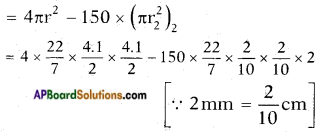
![]()
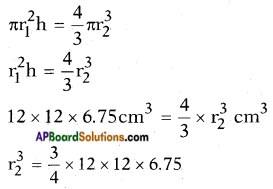
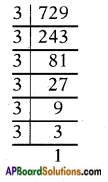
![]()
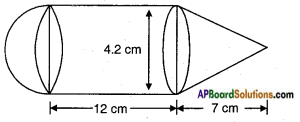
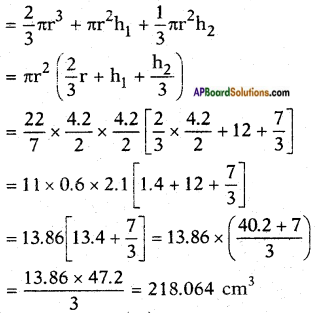

![]()
